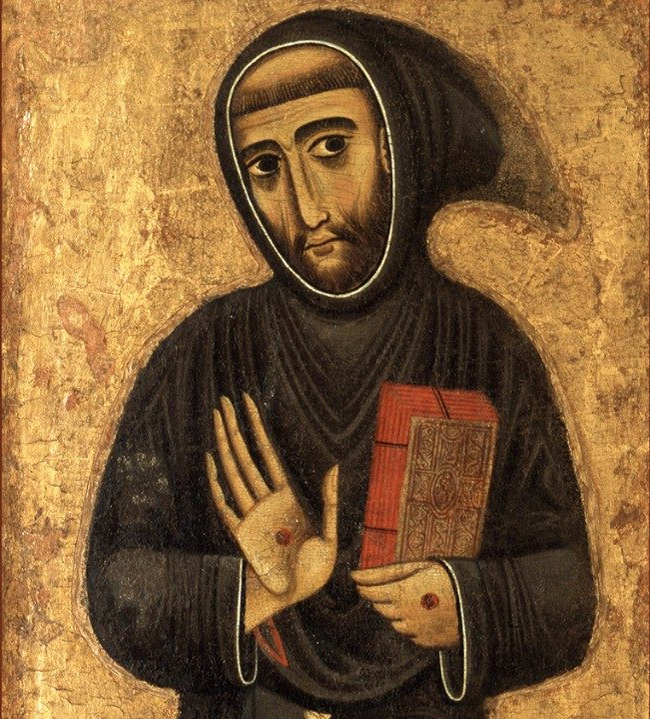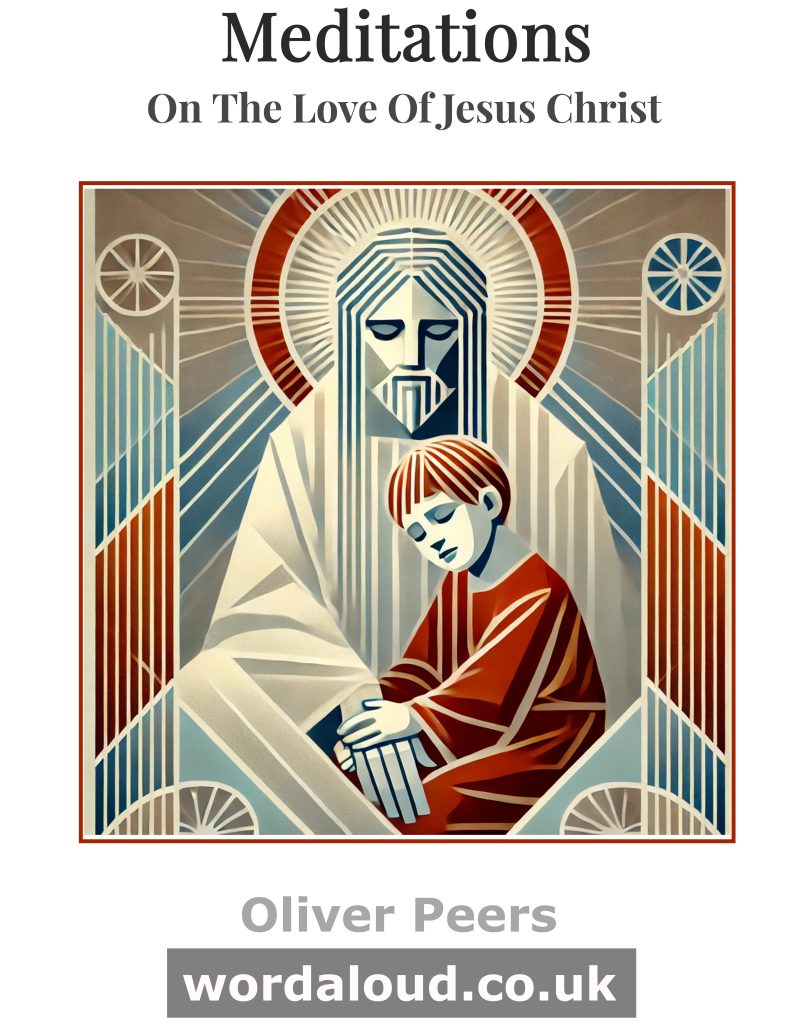Christian Art | Saint Francis Of Assisi
Mark 10: 28-31 (Audio Bible KJV)
Saint Francis of Assisi (1181/82 – 1226) was an Italian Christian friar and preacher who founded the Franciscan order. Saint Francis of Assisi was born into a wealthy family but eventually gave up his luxurious lifestyle to live a life of poverty and service to God. Saint Francis of Assisi is known for his love of all of God’s creation, his mystical experiences, and his teachings on poverty and simplicity.
Early Life Of Saint Francis of Assisi
Saint Francis of Assisi was born in Assisi, Italy in 1181 or 1182 to a wealthy cloth merchant named Pietro di Bernardone and his wife Pica. Saint Francis was baptized Giovanni, but his father later changed his name to Francesco, which means ‘Frenchman’, in honor of his father’s business dealings in France. Saint Francis grew up in luxury, with all the benefits of a wealthy upbringing, including a good education, opportunities for travel, and exposure to the arts.
As a young man, Saint Francis was known for his charm, his love of poetry, and his readiness for adventure. Saint Francis spent much of his time carousing with his friends and engaging in various youthful indiscretions, much to the dismay of his father. When Assisi went to war against the neighboring city-state of Perugia, Saint Francis eagerly joined the military campaign.
However, Saint Francis’ life took a dramatic turn when he was taken prisoner during the war and fell ill. After his release, Saint Francis had a vision in which he heard a voice telling him to return to Assisi and devote himself to God. Saint Francis obeyed the voice, but struggled to find his place in life after his conversion.
Saint Francis began to devote himself to prayer and to serving the poor and outcasts of society. He also began to spend time in nature, which he felt was a manifestation of God’s glory. It was during this time that Saint Francis experienced a profound spiritual awakening that would shape the rest of his life.
One of the most famous stories of Saint Francis’ conversion is the moment when he embraced a leper. Leprosy was a dreaded disease at the time, and lepers were often treated as outcasts. However, Saint Francis felt called to embrace the leper and to show him love and compassion. This act of kindness was a turning point in Saint Francis’ life, as he realized that he could find fulfillment and joy in serving others and in living a life of poverty and simplicity.
Saint Francis began to give away his possessions and to live a life of radical poverty. He wore a simple tunic and begged for his food, relying on the generosity of others. He also began to preach, calling for repentance and a return to a life of simplicity and devotion to God. Saint Francis attracted a small group of followers, who would later become the core of the Franciscan order.
Founding Of The Franciscan Order
After Saint Francis’ conversion and his decision to live a life of poverty and service, he attracted a small group of followers who were drawn to his message of simplicity and devotion to God. These followers, who became known as the ‘lesser brothers’, were inspired by Saint Francis’ example and his teachings, and they began to live a similar lifestyle of poverty and service.
Saint Francis had a vision for the order that he wanted to establish, which he described as ‘the Order of Friars Minor’, or the ‘little brothers’. His vision was for a community of men who would live a life of poverty, chastity, and obedience, and who would dedicate themselves to preaching, serving the poor, and living a life of prayer and contemplation.
The first followers of Saint Francis were a small group of men who had been attracted to his message of simplicity and devotion to God. They included Bernard of Quintavalle, a wealthy merchant who gave away his possessions to the poor, and Peter Catani, a priest who became one of Francis’ closest companions.
Together, Saint Francis and his followers began to live a life of radical poverty, relying on the generosity of others for their basic needs. They also began to preach and to serve the poor and outcasts of society, spreading Francis’ message of repentance and devotion to God.
In 1209, Saint Francis went to Rome to seek approval for his order from Pope Innocent III. The Pope was initially skeptical of Francis’ plans, but he had a dream in which he saw Francis holding up the Lateran Basilica, which had been damaged in an earthquake. The dream convinced the Pope to approve Francis’ order, and he gave Francis and his followers permission to preach and to live a life of poverty.
The founding of the order was marked by the establishment of the ‘Rule of St. Francis’, a set of guidelines that outlined the basic principles of the order. The Rule called for a life of poverty, chastity, and obedience, and emphasized the importance of humility, simplicity, and service to others. The Rule also allowed for the establishment of new communities of friars, who would follow the same principles and live a life of poverty and service.
Spiritual Teachings | Emphasis On Poverty And Simplicity | Love For All Of God’s Creation | Mystical Experiences And Visions
Saint Francis of Assisi is known for his radical teachings and practices, which emphasized the importance of poverty, simplicity, and love for all of God’s creation. Saint Francis’ teachings were rooted in his own mystical experiences and visions, which he saw as a direct revelation of God’s love and wisdom.
One of the central teachings of Saint Francis was the importance of poverty and simplicity. Saint Francis believed that material possessions and wealth were obstacles to spiritual growth, and that true happiness could only be found in a life of poverty and service. Saint Francis lived this teaching himself, choosing to wear simple clothing and to rely on the generosity of others for his basic needs. He also encouraged his followers to do the same, and to see their poverty as a means of drawing closer to God.
Another important aspect of Saint Francis’ teaching was his love for all of God’s creation. Saint Francis believed that everything in the world was a reflection of God’s love and beauty, and that all creatures deserved to be treated with respect and compassion. He even spoke to the animals, seeing them as fellow creatures of God. Saint Francis’ love for creation is reflected in his famous Canticle of the Sun, in which he praises God for the beauty and wonder of the natural world.
Canticle Of The Sun
Translated into English, here is the Canticle Of The Sun, also known as the Canticle Of Brother Sun, written by Saint Francis of Assisi:
Most high, all powerful, all good Lord! All praise is Yours, all glory, all honor, and all blessing. To You, alone, Most High, do they belong. No mortal lips are worthy to pronounce Your name.
Be praised, my Lord, through all Your creatures, especially through my lord Brother Sun, who brings the day; and You give light through him. And he is beautiful and radiant in all his splendor! Of You, Most High, he bears the likeness.
Be praised, my Lord, through Sister Moon and the stars; in the heavens you have made them, precious and beautiful.
Be praised, my Lord, through Brothers Wind and Air, and clouds and storms, and all the weather, through which You give Your creatures sustenance.
Be praised, my Lord, through Sister Water; she is very useful, and humble, and precious, and pure.
Be praised, my Lord, through Brother Fire, through whom You brighten the night. He is beautiful and cheerful, and powerful and strong.
Be praised, my Lord, through our sister Mother Earth, who feeds us and rules us, and produces various fruits with colored flowers and herbs.
Be praised, my Lord, through those who forgive for love of You; through those who endure sickness and trial.
Blessed are those who endure in peace for by You, Most High, they shall be crowned.
Be praised, my Lord, through our Sister Bodily Death, from whose embrace no living person can escape. Woe to those who die in mortal sin! Blessed are those whom death will find in Your most holy will for the second death shall do them no harm.
Praise and bless my Lord, and give thanks, and serve Him with great humility.
Mystical Experiences Of Saint Francis
Saint Francis’ mystical experiences and visions were also a significant aspect of his teaching. Saint Francis saw these experiences as direct revelations of God’s love and wisdom, and he often spoke of them as if they were conversations with God himself. One of Saint Francis’ most famous visions was the experience of the stigmata, in which he received the wounds of Christ on his own body. This experience was seen as a sign of Francis’ deep spiritual union with Christ, and it became an important symbol of his teachings on the importance of suffering and sacrifice.
In addition to his teachings on poverty, simplicity, and love for creation, Saint Francis also emphasized the importance of prayer and contemplation. He believed that prayer was essential for spiritual growth, and that it was a way of deepening one’s relationship with God. He also believed that contemplation was a means of experiencing God’s presence directly, and that it was a way of coming closer to the divine.
Relationship With The Church
Despite his unorthodox approach to Christian living, Saint Francis of Assisi received papal approval for his order in 1209. This approval allowed Francis to continue his mission of preaching and serving the poor without fear of condemnation by the Church. The order was officially recognized as a mendicant order, meaning that the friars were allowed to beg for their daily sustenance, which was crucial to their commitment to poverty.
However, Saint Francis’ relationship with the hierarchy of the Church was not always smooth. Saint Francis was critical of the wealth and corruption he saw within the Church and called for reform. He also rejected the idea of clerical power and authority, instead emphasizing the importance of humility and service. Despite these criticisms, Saint Francis remained loyal to the Church and its teachings. He saw his order as a way of promoting the Gospel and supporting the mission of the Church.
The Franciscan order quickly gained popularity throughout Europe, and by the time of Saint Francis’ death in 1226, there were thousands of friars across the continent. The order’s expansion was due in part to the simplicity and accessibility of Francis’ teachings, which resonated with many people. The friars also played a significant role in the Church’s efforts to combat heresy and promote orthodoxy, particularly through their preaching and teaching.
Despite its success, the Franciscan order faced challenges as it grew in size and influence. Some within the order sought to change its emphasis on poverty and simplicity, leading to internal conflicts and divisions. The order also faced opposition from other religious orders and secular authorities who were suspicious of its growing influence.
Despite these challenges, the Franciscan order continued to thrive, with numerous branches and offshoots developing over the centuries. Today, the order is one of the largest and most influential religious orders in the world, with a presence in over 120 countries. Its commitment to poverty and service remains a defining characteristic, and its members continue to work tirelessly to serve the poor and promote social justice.
In 2013, Cardinal Jorge Mario Bergoglio, Archbishop of Buenos Aires, was elected Pope and chose the name Francis in honor of St. Francis of Assisi. Pope Francis’ decision to take the name Francis is significant, as it reflects his commitment to the same values and teachings that Francis espoused. Pope Francis has often spoken about the importance of simplicity, humility, and service, and has called on the Church to be a force for social justice and compassion in the world.
Stigmata And Later Life
In 1224, Saint Francis of Assisi received the stigmata, the wounds of Christ’s crucifixion, while he was in prayer on Mount Alvernia. This event marked a turning point in Saint Francis’ life and had a profound impact on his spiritual journey. The stigmata was seen as a sign of divine favor and a validation of Saint Francis’ teachings and way of life.
The impact of the stigmata on Saint Francis’ life was significant. It deepened his already intense devotion to Christ and intensified his commitment to poverty and service. Saint Francis saw the stigmata as a sign of his own unworthiness and a reminder of the suffering that Christ endured for humanity. He became even more focused on promoting humility, self-sacrifice, and compassion.
In his later years, Saint Francis’ health declined, and he experienced great physical suffering. Despite this, he continued to serve others, and his compassion for the poor and marginalized remained undiminished. In 1226, Saint Francis traveled to the town of Assisi, where he spent his final days. He died on October 3, 1226, surrounded by his closest followers.
The death of Saint Francis was a significant loss for the Church and for his followers, who saw him as a spiritual guide and mentor. His funeral was attended by thousands of people, and his legacy lived on through his teachings and the Franciscan order.
Franciscan Order After Saint Francis’ Death
Following the death of Saint Francis in 1226, leadership of the Franciscan Order was passed on to Elias of Cortona, a close friend and follower of Francis. However, Elias faced opposition from some members of the order who felt he was straying from Saint Francis’ original vision. This led to a split within the order, with a group of more traditional Franciscans forming their own faction known as the ‘Spirituals.’
The leadership of the order continued to be contentious, with successive ministers general facing opposition from various factions within the order. Despite these challenges, the Franciscans continued to spread throughout Europe and beyond.
The Franciscan Order continued to expand throughout the world in the centuries following Saint Francis’ death. They established missions in Asia, Africa, and the Americas, and played an important role in spreading Christianity to new regions.
One notable example is the mission to the Americas led by Junipero Serra, a Spanish Franciscan friar. Serra founded nine missions in California between 1769 and 1782, and is considered a founding father of California.
The Franciscan Order had a significant impact on both the Church and society. They were known for their commitment to poverty and simplicity, which stood in contrast to the wealth and extravagance of the Church at the time. This led to the Franciscans being seen as a voice for reform within the Church.
Their missionary work also had a profound impact on the societies they encountered. They were often the first Europeans to establish relationships with indigenous peoples in the Americas, and worked to learn local languages and customs in order to better communicate with them. This approach was in contrast to the more hostile and exploitative approach taken by some other European colonizers.
In addition to their missionary work, the Franciscans also played an important role in the development of art and literature. They were patrons of artists such as Giotto and Simone Martini, and many important literary works were written by Franciscan friars.
Pope Francis And The Name
When Cardinal Jorge Bergoglio was elected as Pope in 2013, he chose the name Francis in honour of Saint Francis of Assisi. This was significant, as no Pope had ever chosen this name before.
The name Francis is associated with humility, poverty, and a commitment to social justice – all values that are central to the Franciscan tradition. By choosing this name, Pope Francis signaled his commitment to these values and his desire to lead a more humble and compassionate Church.
Pope Francis has spoken about his admiration for Saint Francis on many occasions. In his first homily as Pope, he referred to Saint Francis as the ‘man of poverty’ and the ‘man of peace,’ and called on the Church to ‘protect creation, to protect every man and every woman, to look upon them with tenderness and love, and to leave no room for hatred and indifference.’
Pope Francis has also visited Assisi, the birthplace of Saint Francis, several times as Pope. During these visits, he has prayed at the tomb of Saint Francis and met with Franciscan friars, whom he has praised for their commitment to social justice.
Pope Francis’ papacy has been marked by a number of actions that reflect the legacy of Saint Francis. One notable example is his commitment to poverty and simplicity. Pope Francis has chosen to live in a modest apartment rather than the grand papal apartments, and has urged Church leaders to focus on the needs of the poor and marginalized.
Pope Francis has also spoken out on a number of social justice issues, including climate change and immigration. In his encyclical letter Laudato Si, Pope Francis called on all people to care for the environment and work to address the effects of climate change. Pope Franics has also spoken out against the rise of populism and nationalism, and has called on countries to welcome refugees and migrants.
Another way in which Pope Francis has reflected the legacy of Saint Francis is through his commitment to interfaith dialogue. He has met with leaders of other religions, including Islam and Judaism, and has emphasized the importance of building bridges between different faiths.
Legacy And Influence Of Saint Francis
Saint Francis of Assisi is one of the most beloved figures in the history of Catholicism and Christianity as a whole. His radical commitment to poverty, simplicity, and humility continues to inspire people around the world.
The Franciscan order that he founded has had a significant impact on the Church, particularly in its emphasis on serving the poor and marginalized. The Franciscans have also been leaders in the areas of interfaith dialogue and environmental stewardship.
Francis’ emphasis on poverty and simplicity has also influenced other religious orders, such as the Jesuits and the Dominicans. His example has challenged Christians of all denominations to live more simply and to be more attentive to the needs of the poor.
Saint Francis of Assisi has had a profound impact on society and culture. His emphasis on poverty, simplicity, and love for all creation has inspired countless individuals and movements throughout history.
One example of Saint Francis’ impact is the development of the Renaissance. The Franciscan order played a significant role in the intellectual and artistic developments of the period, particularly in Italy.
Saint Francis’ commitment to peace and reconciliation has also inspired movements for social justice and nonviolence. In the 20th century, the Catholic Worker movement, founded by Dorothy Day and Peter Maurin, was heavily influenced by Saint Francis’ example.
Saint Francis of Assisi’s life and teachings continue to offer valuable lessons for people of all faiths and backgrounds.
Perhaps the most important lesson is the value of humility and simplicity. Francis’ example challenges us to let go of our attachments to material possessions and to focus on what truly matters – our relationships with God and with each other.
Another lesson that can be learned from Saint Francis’ life is the importance of caring for the environment. Francis saw all of creation as a gift from God, and he called on us to be responsible stewards of the earth.
Finally, Saint Francis’ emphasis on peace and reconciliation is a lesson that is as relevant today as it was in his time. His commitment to nonviolence challenges us to seek peaceful solutions to conflicts and to work for the well-being of all people.
The Canticle Of The Sun – Original Text In Italian
Altissimu onnipotente bon Signore, Tue so’ le laude, la gloria e l’honore et onne benedictione. Ad Te solo, Altissimo, se konfano, et nullu homo ène dignu te mentovare.
Laudato sie, mi’ Signore, cum tucte le Tue creature, spetialmente messor lo frate Sole, lo qual’è iorno, et allumini noi per loi. Et ellu è bellu e radiante cum grande splendore: de Te, Altissimo, porta significatione.
Laudato si’, mi’ Signore, per sora Luna e le stelle: in celu l’ài formate clarite et pretiose et belle. Laudato si’, mi’ Signore, per frate Vento, et per aere et nubilo et sereno et onne tempo, per lo quale, a le Tue creature dài sustentamento.
Laudato si’, mi’ Signore, per sor’Acqua, la quale è multo utile et humile et pretiosa et casta. Laudato si’, mi’ Signore, per frate Focu, per lo quale ennallumini la nocte: ed ello è bello et iocundo et robustoso et forte.
Laudato si’, mi’ Signore, per sora nostra matre Terra, la quale ne sustenta et governa, et produce diversi fructi con coloriti flori et herba. Laudato si’, mi’ Signore, per quelli che perdonano per lo Tuo amore, et sostengono infirmitate et tribulatione. Beati quelli ke ‘l sosterranno in pace, ka da Te, Altissimo, sirano incoronati.
Laudato si’ mi’ Signore, per sora nostra Morte corporale, da la quale nullu homo vivente pò skappare: guai a quelli ke morrano ne le peccata mortali; beati quelli ke trovarà ne le Tue sanctissime voluntati, ka la morte secunda no ‘l farrà male.
Laudate et benedicete mi’ Signore, et rengratiate, e serviateli cum grande humilitate.








